I've always had a love-hate relationship with hipon (shrimp). Yes, I'm one of those Pinoys who developed shrimp allergy later in life (relate much?). But let me tell you, Rellenong Hipon is worth keeping antihistamines handy.
Every time I make these crispy stuffed shrimp rolls for family gatherings, I can't help but sneak one or two despite my allergies. The moment that golden-brown wrapper crunches between your teeth, revealing the perfect marriage of juicy shrimp and savory pork filling inside, you'll understand why I just can't resist.
I've spent years perfecting this heirloom recipe, making it dozens of times for birthdays, fiestas, and even simple family dinners when I want to make ordinary days feel special. While your lola might have her own version (don't they all?), this recipe combines the best techniques I've learned, from choosing the right size of hipon to the perfect wrapper-rolling technique that prevents oil from seeping in.
It's my Tita Delie's recipe, passed down with all those little secrets that make it extra special, and now I'm sharing it with you.
Jump to:
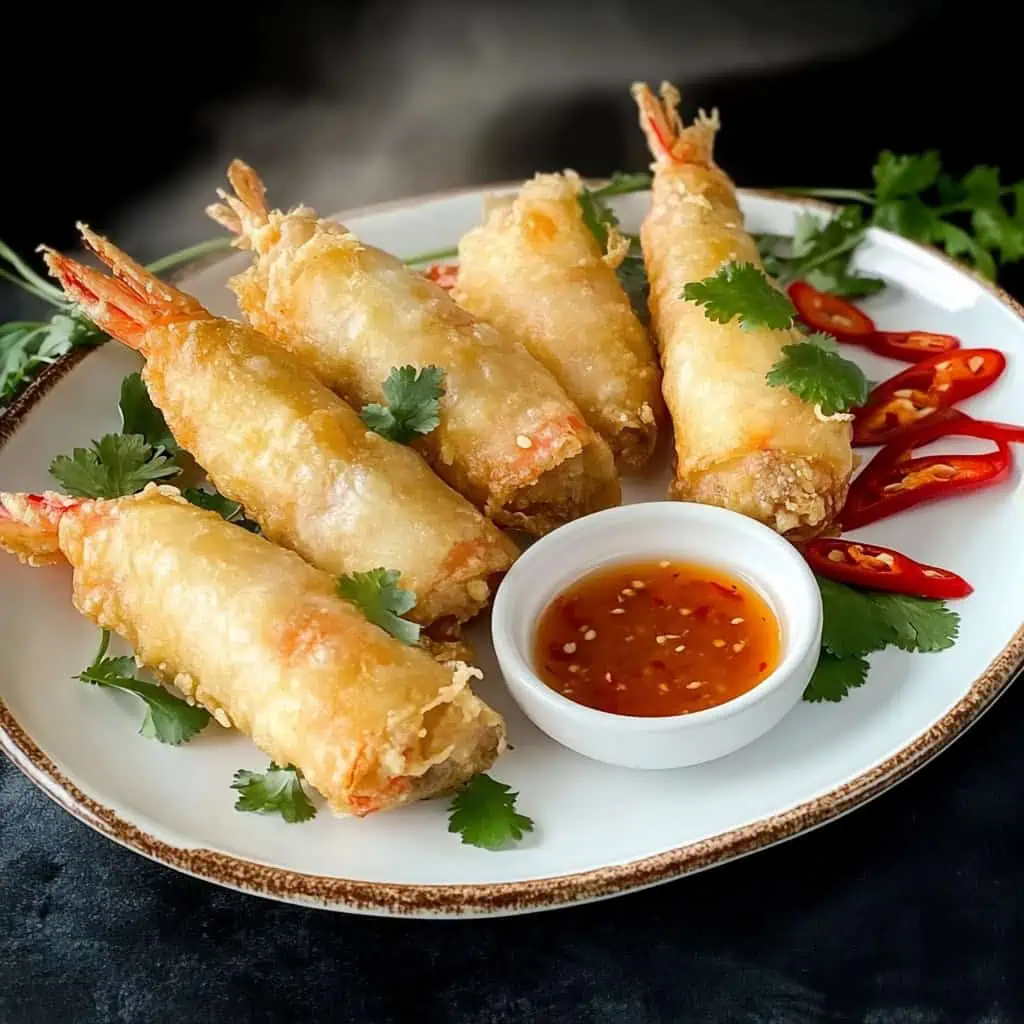
Why You'll Love This Recipe
- Perfect blend of crispy exterior and juicy interior
- Make-ahead friendly for party planning
- Impressive presentation with minimal effort
- Versatile dipping sauce options
- Restaurant-quality appetizer made at home
- Budget-friendly party food
Ingredients
Each element in this recipe plays an essential role in creating the perfect Rellenong Hipon. Large shrimp provide the perfect vessel for stuffing while maintaining a juicy bite. Ground pork adds richness and savory flavor, while water chestnuts and carrots contribute a refreshing crunch.
Green onions and garlic infuse the filling with aromatic depth, and soy sauce brings umami that balances the natural sweetness of the shrimp. The spring roll wrappers create that signature golden, crispy exterior that makes this dish irresistible.
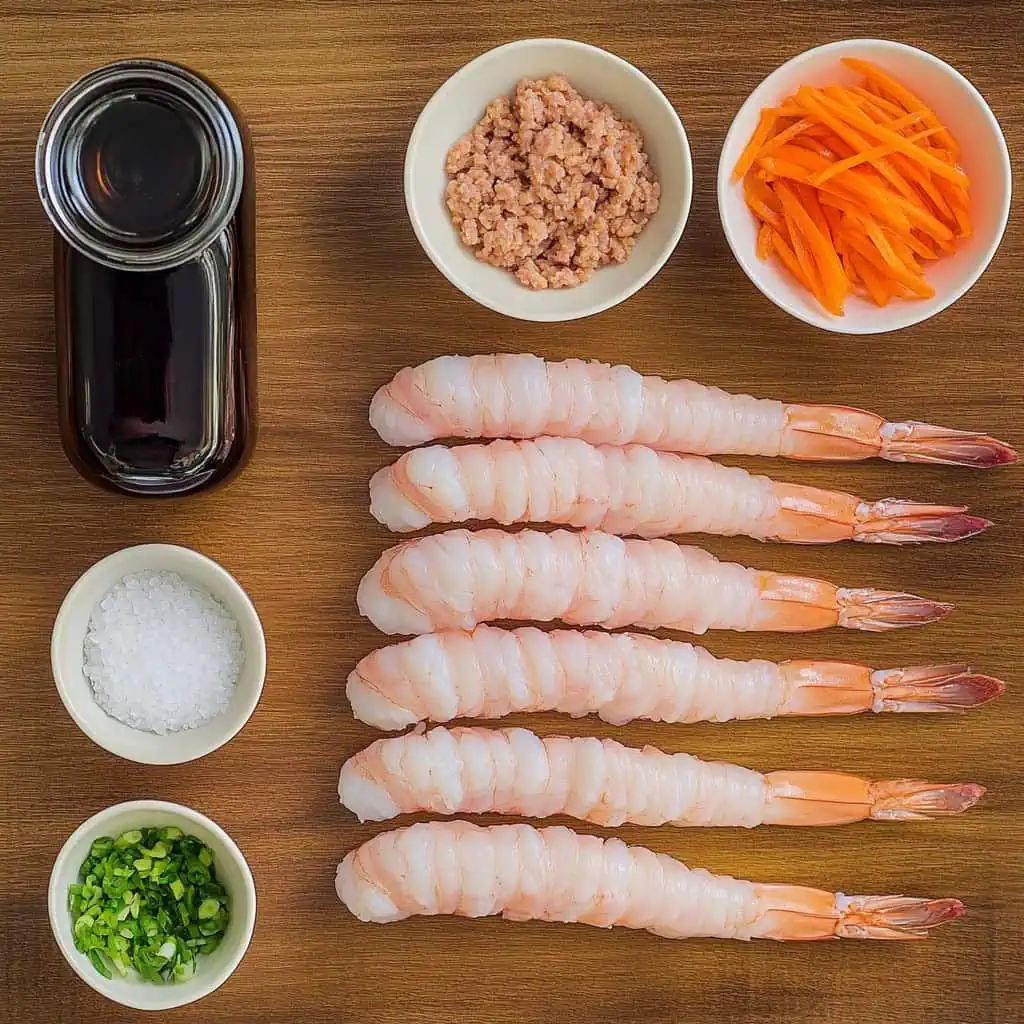
For the Shrimp:
- 1 pound large shrimp (31-35 count)
- 15 pieces spring roll wrappers (lumpia wrappers), cut diagonally
- Canola oil for frying
For the Filling:
- ¼ pound ground pork
- ¼ cup green onions, chopped
- ¼ cup water chestnuts, finely chopped
- ¼ cup carrots, shredded
- 2 cloves garlic, peeled and minced
- 1 teaspoon soy sauce
- ½ teaspoon salt
- ¼ teaspoon pepper
Equipment
- Deep frying pan or wok (kawali) - Provides even heat distribution for perfectly crispy rolls
- Candy/oil thermometer - Ensures oil stays at the ideal 350°F temperature for crispy, not greasy, results
- Spider strainer (siyanse) - Allows for gentle removal of delicate rolls from hot oil
- Sharp knife (kutsilyo) - Essential for properly butterflying shrimp and precise ingredient preparation
- Cutting board (sangkalan) - Preferably with juice groove to contain seafood liquids
- Paper towels - Absorbs excess oil after frying for crispier rolls
- Wire cooling rack - Maintains crispiness by allowing air circulation
- Small bowl with water - Used for sealing wrapper edges securely
- Kitchen scale - Ensures consistent portions for even cooking
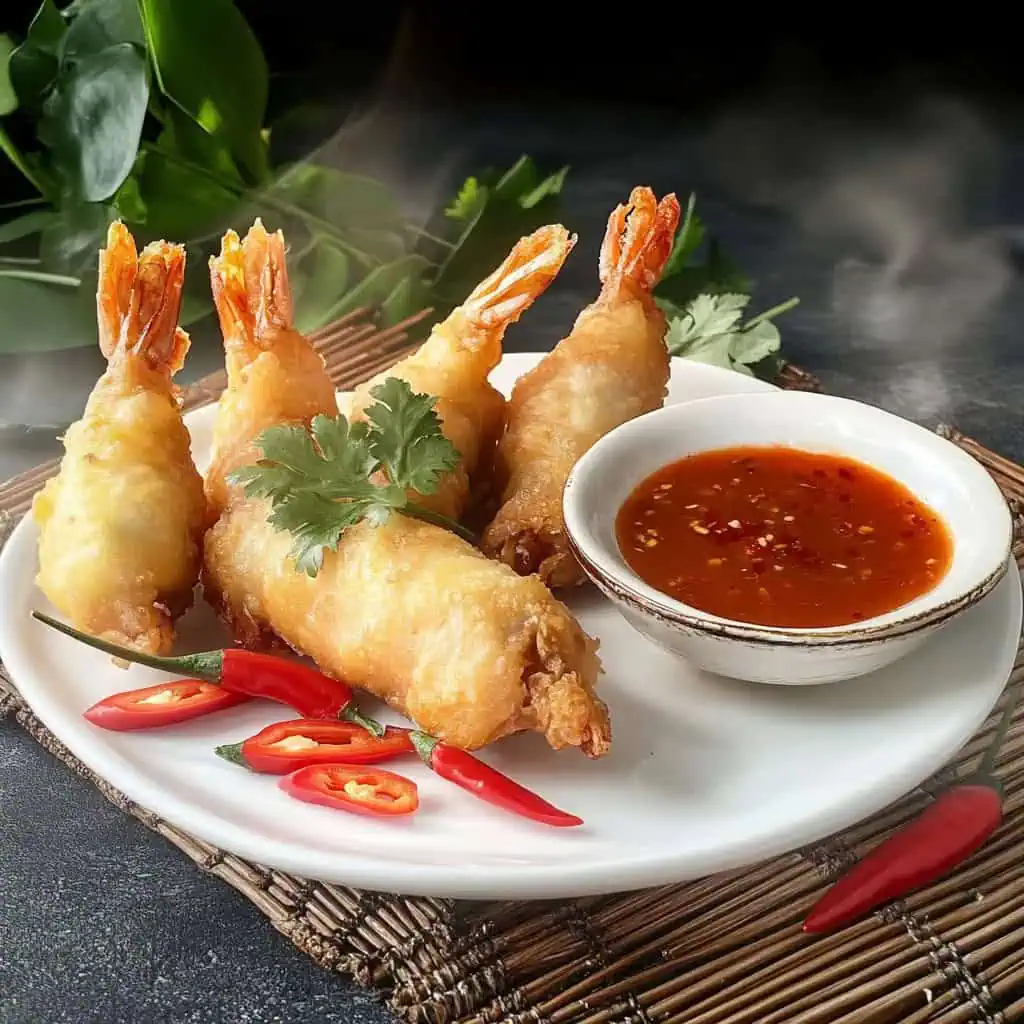
How To Make
- Peel your shrimp but keep the tails on. Cut down the back of each shrimp and remove the dark vein. Open up the shrimp like a book until it lies flat. Set these prepared shrimp aside.
- Mix together ground pork, chopped green onions, water chestnuts, carrots, minced garlic, soy sauce, salt, and pepper in a bowl until everything is well combined.
- Put about half a teaspoon of the pork mixture onto each butterflied shrimp. Close the shrimp gently around the filling, making sure it's not overstuffed.
- Take your spring roll wrapper and cut it diagonally to make two triangles. Place a stuffed shrimp on the wrapper with the pointed end facing up. Fold the side over, then roll it up tightly like a spring roll. Use a bit of water on the edges to seal it closed. Keep your wrapped shrimps under a damp paper towel while you finish wrapping the rest.
- Heat about 2 inches of oil in your pan until it reaches 350°F (177°C). You can test if it's ready by putting a small piece of wrapper in - it should bubble gently and float to the top.
- Carefully place your wrapped shrimp in the hot oil, seam-side down first. Don't overcrowd the pan - fry them in batches if needed. Cook for about 4-5 minutes, turning occasionally, until they're golden brown and crispy.
- Take them out and let them drain on a wire rack or paper towels. Serve them right away while they're hot and crispy with sweet chili sauce for dipping.

Tips from Lola's Kitchen
- Choose fresh, not frozen shrimp for the best flavor and texture. Fresh shrimp have a sweeter taste and firmer texture that holds up better during cooking.
- Butterfly the shrimp properly by cutting deep enough but not all the way through. This creates more surface area for the filling while keeping the shrimp intact.
- Devein completely to avoid any bitter taste. The dark vein is actually the shrimp's digestive tract and can impart an unpleasant flavor if left in.
- Keep size consistent when choosing shrimp for even cooking. Aim for large shrimp (31-35 count per pound) for the perfect bite-sized roll.
- Don't overstuff the shrimp or the filling may burst during frying. Half a teaspoon is the perfect amount.
- Keep wrapped rolls covered with a damp cloth while working to prevent the wrappers from drying out.
- Test oil temperature with a wooden chopstick - small bubbles should form around it when the oil is ready.
- Fry seam-side down first to properly seal the wrapper and prevent filling from escaping.
- Work in small batches when frying to maintain oil temperature and give each roll enough space.
- Allow oil to reheat between batches for consistently crispy results.
Substitutions
- Ground chicken or turkey can replace pork for a lighter option. Just add a teaspoon of cooking oil to the mixture to maintain juiciness.
- Jicama (singkamas) makes an excellent substitute for water chestnuts, providing the same refreshing crunch.
- Rice paper can be used instead of spring roll wrappers, though the texture will be slightly different.
- Chives work well in place of green onions for a milder flavor.
- Mushroom and tofu filling can create a vegetarian version, but you'll need to drain and press the tofu first to remove excess moisture.
- Cornstarch slurry (1 tablespoon cornstarch + 2 tablespoons water) can replace the egg wash for sealing wrappers if you're making an egg-free version.
- Avocado or peanut oil can substitute for canola oil, providing a higher smoke point ideal for deep frying.
Troubleshooting
- Wrapper breaking during rolling
- Problem: Wrappers are too dry or brittle
- Solution: Ensure wrappers are at room temperature and kept under a damp cloth. Work quickly and keep unused wrappers covered.
- Oil too hot/cold
- Problem: Rolls browning too quickly or absorbing too much oil
- Solution: Maintain 350°F using a thermometer. Adjust heat as needed between batches.
- Filling falling out during frying
- Problem: Wrappers not sealed properly
- Solution: Apply water generously to sealing edges and press firmly. Double-check seals before frying.
- Shrimp curling during frying
- Problem: Natural tendency of shrimp to curl when heated
- Solution: Make small incisions near the tail end or use toothpicks to maintain shape during preparation.
- Rolls not crispy enough
- Problem: Oil temperature too low or rolls placed too close together
- Solution: Ensure proper oil temperature and fry in small batches with plenty of space between rolls.
Storage & Reheating
Storage:
- Uncooked rolls can be frozen for up to 3 months. Arrange in a single layer on a baking sheet until frozen solid, then transfer to freezer bags.
- Cooked rolls are best consumed immediately for optimal crispiness.
- Refrigerate leftovers in an airtight container for up to 2 days, though the texture will never be as crispy as fresh.
Reheating:
- Oven method: Preheat to 350°F (177°C) and bake for 5-7 minutes until heated through and crispy again.
- Air fryer method: 350°F (177°C) for 3-4 minutes provides excellent crispiness restoration.
- Avoid microwave reheating as it makes the wrapper soggy and chewy.
- To reheat frozen uncooked rolls: Fry directly from frozen, adding an extra minute or two to the cooking time.
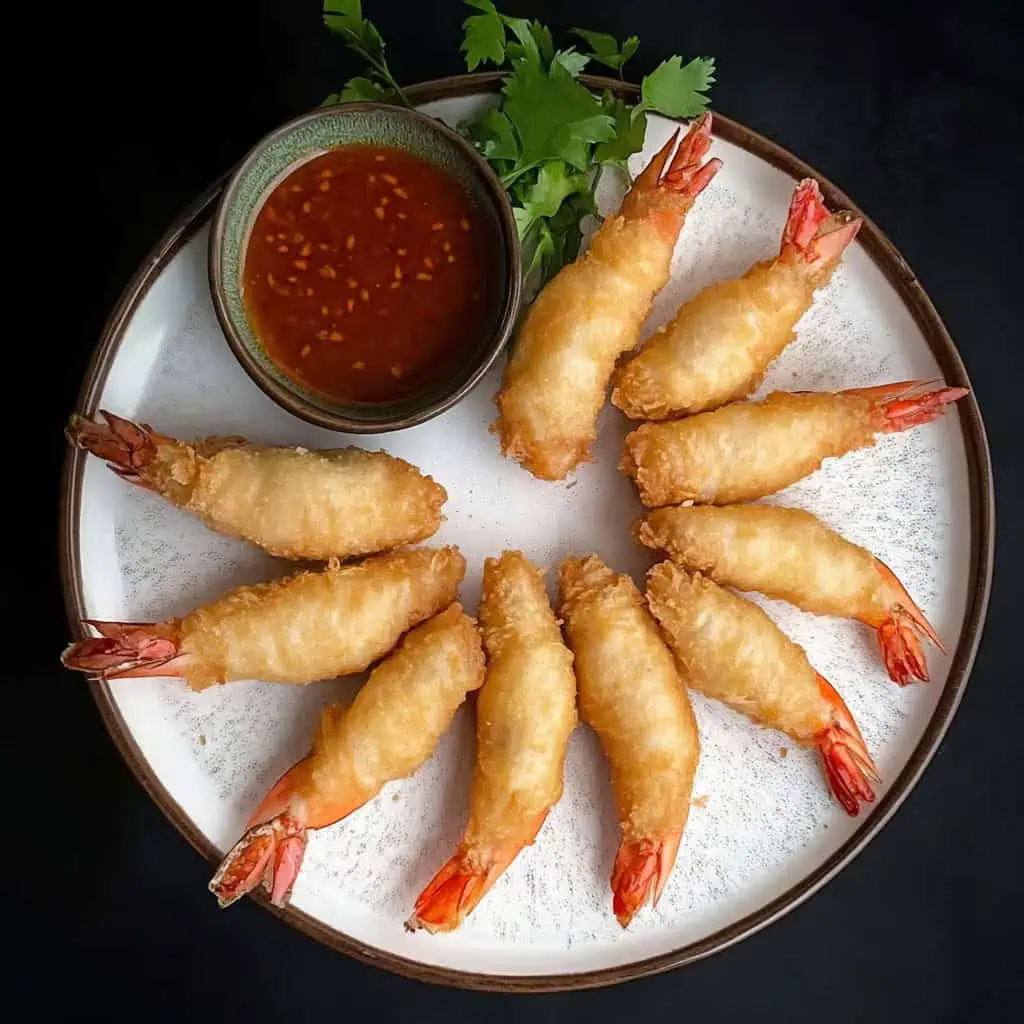
FAQ
Can I make these ahead for a party?
Yes! Prepare through the wrapping stage and freeze uncooked rolls for up to 3 months. Fry directly from frozen when ready to serve, adding 1-2 minutes to the cooking time.
Why are my rolls not crispy?
Common causes include oil temperature too low, overcrowding in the pan, or too much moisture in the filling. Use a thermometer, fry in small batches, and ensure vegetables are patted dry.
Can I air fry these instead of deep frying?
Yes! Preheat your air fryer to 375°F (190°C), spray the rolls lightly with oil, and cook for 8-10 minutes, turning halfway through. The texture will be slightly different but still delicious.
How do I prevent oil splatter during frying?
Pat shrimp and all ingredients dry before wrapping, maintain proper oil temperature, and avoid dropping rolls into oil from a height. A splatter screen can also help.
Can I use pre-cooked shrimp?
Not recommended as they'll become overcooked and rubbery during the frying process. Always start with raw shrimp for the best texture.
How do I know when the pork filling is properly cooked?
The pork will cook during the frying process. As long as the pieces are small and your oil is at the right temperature, 4-5 minutes of frying should cook the filling completely.
My wrappers are bubbling too much during frying. What's wrong?
Excess moisture causes bubbling. Make sure to pat all ingredients dry and seal wrappers completely to prevent steam from forming inside.
Can I make a dipping sauce from scratch?
Absolutely! A simple sweet chili sauce can be made by combining ¼ cup rice vinegar, 2 tablespoons sugar, 1 minced garlic clove, 1 teaspoon red pepper flakes, and a pinch of salt. Simmer until slightly thickened.
Related
Looking for other recipes like this? Try these:
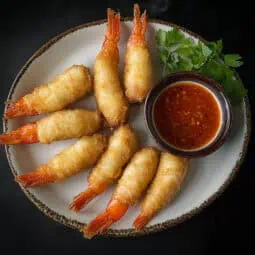
Crispy Rellenong Hipon (Filipino Stuffed Shrimp Rolls)
Equipment
- Deep frying pan or wok (kawali) for achieving even cooking temperature
- Candy/oil thermometer to maintain proper oil temperature
- Spider strainer (siyanse) for safe and easy removal of fried rolls
- Sharp knife (kutsilyo) for butterflying shrimp and chopping ingredients
- Cutting board (Sangkalan) preferably with juice groove for seafood
- Paper towels for draining excess oil
- Wire cooling rack for maintaining crispiness
- Small bowl with water for sealing wrappers
- Kitchen scale for accurate measurements
Ingredients
For the Shrimp:
- 1 pound large shrimp 31-35 count (hipon)
- 15 pieces spring roll wrappers lumpia wrapper, cut diagonally
- Canola oil for frying
For the Filling:
- ¼ pound ground pork giniling na baboy
- ¼ cup green onions chopped (sibuyas na mura)
- ¼ cup water chestnuts finely chopped (singkamas)
- ¼ cup carrots shredded (karot)
- 2 cloves garlic peeled and minced (bawang)
- 1 teaspoon soy sauce toyo
- ½ teaspoon salt asin
- ¼ teaspoon pepper paminta
Instructions
- First, peel your shrimp but keep the tails on. Cut down the back of each shrimp and remove the dark vein. Open up the shrimp like a book until it lies flat. Set these prepared shrimp aside.
- Mix together ground pork, chopped green onions, water chestnuts, carrots, minced garlic, soy sauce, salt, and pepper in a bowl until everything is well combined.
- Put about half a teaspoon of the pork mixture onto each butterflied shrimp. Close the shrimp gently around the filling, making sure it's not overstuffed.
- Take your spring roll wrapper and cut it diagonally to make two triangles. Place a stuffed shrimp on the wrapper with the pointed end facing up. Fold the side over, then roll it up tightly like a spring roll. Use a bit of water on the edges to seal it closed. Keep your wrapped shrimps under a damp paper towel while you finish wrapping the rest.
- Heat about 2 inches of oil in your pan until it reaches 350°F (177°C). You can test if it's ready by putting a small piece of wrapper in - it should bubble gently and float to the top.
- Carefully place your wrapped shrimp in the hot oil, seam-side down first. Don't overcrowd the pan - fry them in batches if needed. Cook for about 4-5 minutes, turning occasionally, until they're golden brown and crispy.
- Take them out and let them drain on a wire rack or paper towels. Serve them right away while they're hot and crispy with sweet chili sauce for dipping.
- Remember: If you're making these ahead, you can prepare everything up to the wrapping step, then freeze them uncooked. Just fry them straight from frozen when you're ready to serve, adding an extra minute or two to the cooking time.
Tips from Lola's Kitchen
- Choose fresh, not frozen shrimp for best results
- Devein shrimp completely to avoid bitter taste
- Don't overstuff to ensure even cooking
- Keep wrapped rolls covered with damp cloth while working
- Test oil temperature with a wooden chopstick - small bubbles should form around it
- Fry seam-side down first to seal properly
Nutrition
The Story Behind Rellenong Hipon
Rellenong Hipon, with its crispy exterior and flavorful meat-stuffed shrimp, tells the fascinating story of Filipino cuisine's Spanish colonial influence. The name itself is a perfect marriage of two cultures - "relleno" coming from the Spanish word meaning "stuffed" or "filled," and "hipon," the Tagalog word for shrimp. This beloved appetizer emerged during the 333 years of Spanish colonial rule in the Philippines, when European cooking techniques began blending with local Filipino ingredients and preparations.
While traditional Spanish rellenos often featured stuffed peppers or chicken, Filipino ingenuity adapted the technique to showcase the abundance of fresh seafood in our archipelago. Our ancestors, particularly in coastal regions like Pangasinan and Capiz (known as the seafood capital of the Philippines), transformed the humble hipon into an elegant party dish by butterflying and stuffing it with a savory ground pork filling - a technique that would become a cornerstone of Filipino celebration food.
Today, Rellenong Hipon stands as a testament to Filipino culinary creativity, appearing at everything from intimate family gatherings to grand fiestas. The dish has evolved from its Spanish-era roots, with modern versions incorporating distinctly Asian elements like water chestnuts and spring roll wrappers instead of the traditional breading. What started as a Spanish cooking method has become thoroughly Filipinized, creating something uniquely ours that showcases the best of our local ingredients and flavors.
This appetizer's enduring popularity isn't just about its delicious taste - it's about the care and skill that goes into making each piece. The meticulous preparation, from butterflying the shrimp to carefully wrapping each piece, reflects the Filipino value of putting love and effort into food preparation. Whether served at a casual family dinner or as the star appetizer at a celebration, Rellenong Hipon continues to be a beloved part of Filipino cuisine, bridging our colonial past with our vibrant culinary present.
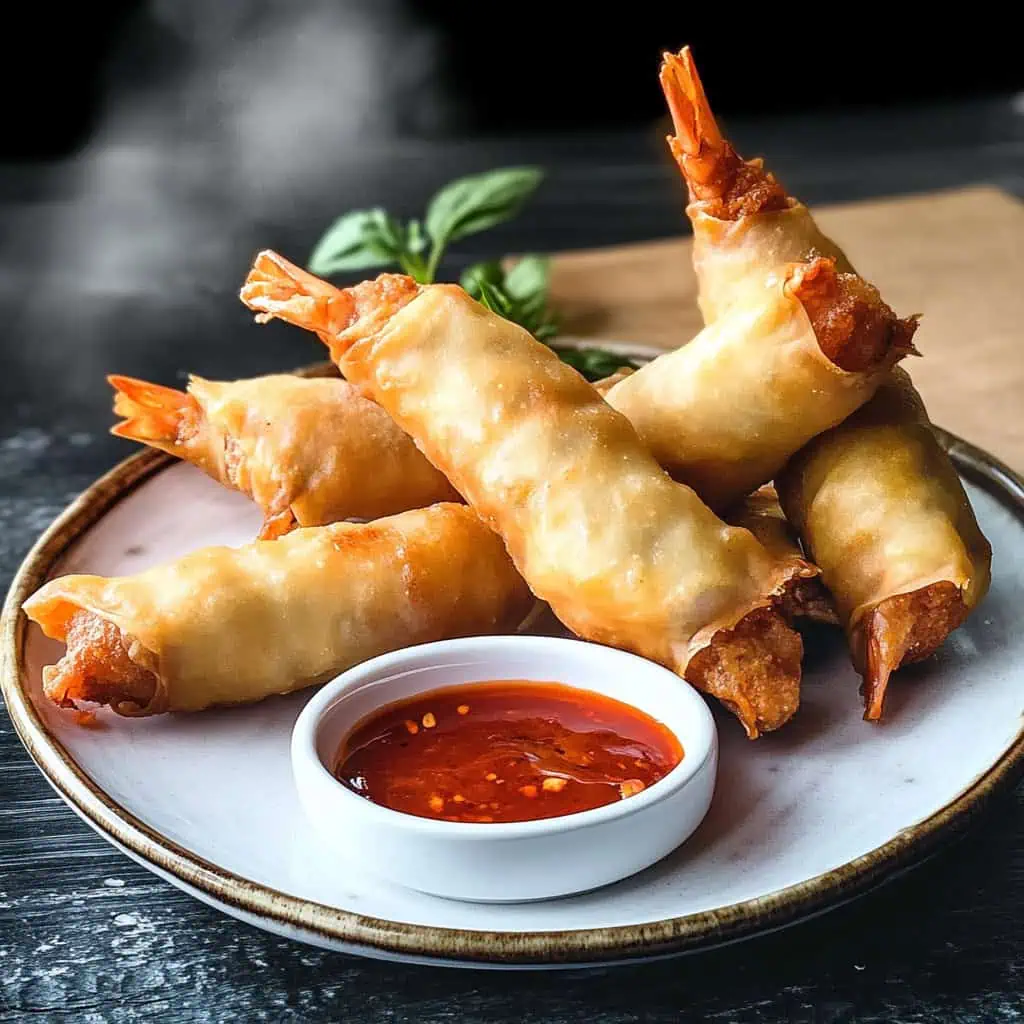





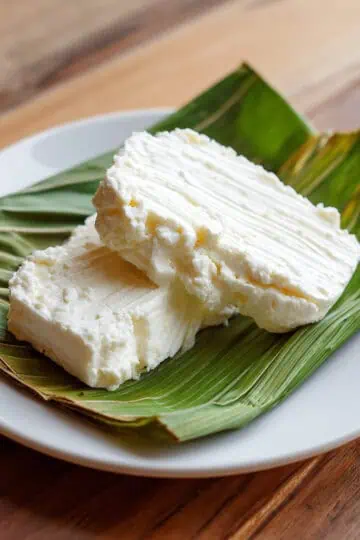
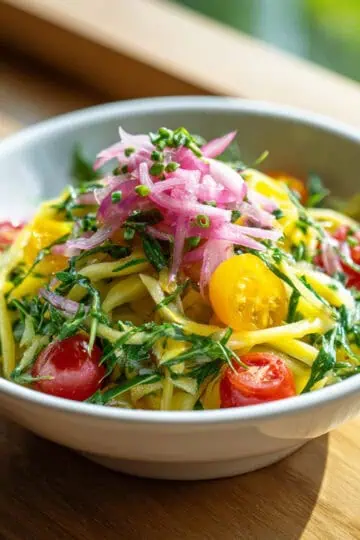
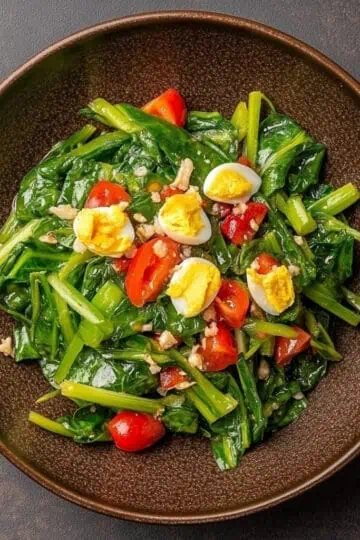
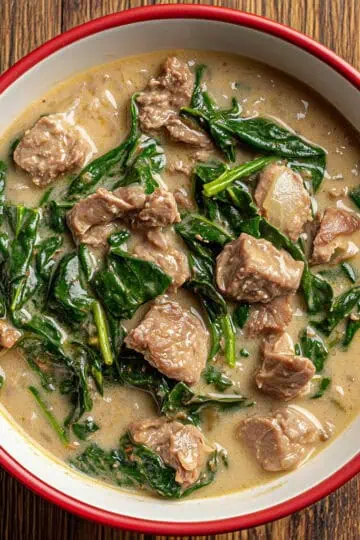
Comments
No Comments